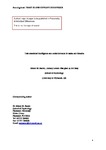Trait emotional intelligence and social deviance in males and females
| dc.contributor.author | Bacon, Alison | |
| dc.contributor.author | Lenton-Maughan, L | |
| dc.contributor.author | May, Jon | |
| dc.date.accessioned | 2017-10-12T09:39:29Z | |
| dc.date.available | 2017-10-12T09:39:29Z | |
| dc.date.issued | 2017-10-16 | |
| dc.identifier.issn | 0191-8869 | |
| dc.identifier.issn | 1873-3549 | |
| dc.identifier.uri | http://hdl.handle.net/10026.1/10051 | |
| dc.description.abstract |
High trait Emotional Intelligence (trait EI) is often considered a positive attribute, but some studies have suggested that it may facilitate deception or manipulative relational behaviours, and that the effects differ according to gender. In two studies, we examine the influence of trait EI factors on social deviance, from adolescence through to adulthood. A total of 455 participants (243 females) completed the Trait EI Questionnaire and provided self-reports of deviant behaviours during adolescence and emerging adulthood (Study 1) or in adulthood (Study 2). For males, adolescent and emerging adult deviance related negatively to Emotionality and Self-control, in accordance with positive views of trait EI, but in adulthood deviance was predicted only by high Sociability. For females, the opposite pattern was seen, with high levels of Emotionality and Sociability associated with deviance in adolescence and high Sociability in emerging adulthood. Adult female social deviance was negatively correlated with Self-control and Emotionality, replicating the adolescent male profile. Trait EI is not inevitably positive, and is an under-researched personality determinant of social deviance. Further consideration of the developmental trajectory of trait EI may provide insights to inform intervention with at-risk individuals in adolescence, and beyond. | |
| dc.format.extent | 79-86 | |
| dc.language | en | |
| dc.language.iso | en | |
| dc.publisher | Elsevier | |
| dc.subject | Trait emotional intelligence | |
| dc.subject | Antisocial behaviour | |
| dc.subject | Social deviance | |
| dc.subject | Gender differences | |
| dc.subject | Emerging adulthood | |
| dc.subject | Adolescence | |
| dc.subject | TEI-Que | |
| dc.title | Trait emotional intelligence and social deviance in males and females | |
| dc.type | journal-article | |
| dc.type | Journal Article | |
| plymouth.author-url | https://www.webofscience.com/api/gateway?GWVersion=2&SrcApp=PARTNER_APP&SrcAuth=LinksAMR&KeyUT=WOS:000417774900014&DestLinkType=FullRecord&DestApp=ALL_WOS&UsrCustomerID=11bb513d99f797142bcfeffcc58ea008 | |
| plymouth.volume | 122 | |
| plymouth.publication-status | Published | |
| plymouth.journal | Personality and Individual Differences | |
| dc.identifier.doi | 10.1016/j.paid.2017.10.015 | |
| plymouth.organisational-group | /Plymouth | |
| plymouth.organisational-group | /Plymouth/Faculty of Health | |
| plymouth.organisational-group | /Plymouth/Faculty of Health/School of Psychology | |
| plymouth.organisational-group | /Plymouth/REF 2021 Researchers by UoA | |
| plymouth.organisational-group | /Plymouth/REF 2021 Researchers by UoA/UoA04 Psychology, Psychiatry and Neuroscience | |
| plymouth.organisational-group | /Plymouth/REF 2021 Researchers by UoA/UoA04 Psychology, Psychiatry and Neuroscience/UoA04 REF peer reviewers | |
| plymouth.organisational-group | /Plymouth/Research Groups | |
| plymouth.organisational-group | /Plymouth/Research Groups/Centre for Brain, Cognition and Behaviour (CBCB) | |
| plymouth.organisational-group | /Plymouth/Research Groups/Centre for Brain, Cognition and Behaviour (CBCB)/Behaviour | |
| plymouth.organisational-group | /Plymouth/Research Groups/Institute of Health and Community | |
| plymouth.organisational-group | /Plymouth/Research Groups/Plymouth Institute of Health and Care Research (PIHR) | |
| plymouth.organisational-group | /Plymouth/Users by role | |
| plymouth.organisational-group | /Plymouth/Users by role/Academics | |
| dcterms.dateAccepted | 2017-10-11 | |
| dc.rights.embargodate | 2019-10-16 | |
| dc.identifier.eissn | 1873-3549 | |
| dc.rights.embargoperiod | Not known | |
| rioxxterms.versionofrecord | 10.1016/j.paid.2017.10.015 | |
| rioxxterms.licenseref.uri | http://www.rioxx.net/licenses/all-rights-reserved | |
| rioxxterms.licenseref.startdate | 2017-10-16 | |
| rioxxterms.type | Journal Article/Review |


